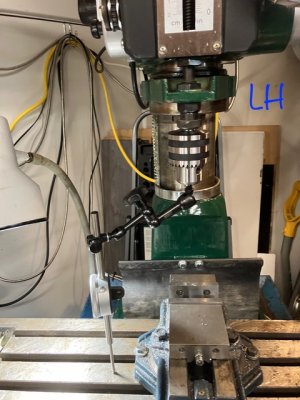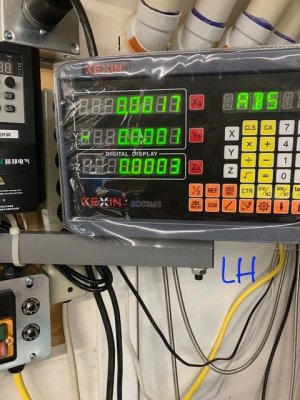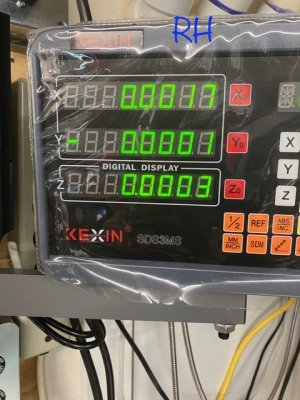So I've trammed my new RF30 mill, and I have a question on the validity of my results.
I installed a three-axis DRO, and confirmed the axis calibration by chucking a 2" throw dial indicator in a drill chuck. Zeroed the dial indicator at end of travel against the table, zeroed the DRO, and extended the quill 2.000" as read on the dial indicator. Confirmed DRO read 2.000" travel.
So today I chucked the same 2" throw dial indicator in a holder, zeroed it with about 0.200" of quilll extension, with the tip placed as far to the right as I could, zeroed the DRO. Moved the quill up and down to the zero point, DRO reads 0.0003", so I know the DRO is active and that's within the 5 micro resolution. Lifted the quill so the dial indicator wasn't touching the table, and spun the quill 180* without touching the dial indicator or chuck (spun it using the spindle pulley). Extended the quill to the same zero point at 0.200" extensions, and compared the DRO reading. DRO read the same 0.0003".
Is this a valid way to check tram? If I try to spin the quill with the dial indicator touching the table it twists and goes out of true.



I installed a three-axis DRO, and confirmed the axis calibration by chucking a 2" throw dial indicator in a drill chuck. Zeroed the dial indicator at end of travel against the table, zeroed the DRO, and extended the quill 2.000" as read on the dial indicator. Confirmed DRO read 2.000" travel.
So today I chucked the same 2" throw dial indicator in a holder, zeroed it with about 0.200" of quilll extension, with the tip placed as far to the right as I could, zeroed the DRO. Moved the quill up and down to the zero point, DRO reads 0.0003", so I know the DRO is active and that's within the 5 micro resolution. Lifted the quill so the dial indicator wasn't touching the table, and spun the quill 180* without touching the dial indicator or chuck (spun it using the spindle pulley). Extended the quill to the same zero point at 0.200" extensions, and compared the DRO reading. DRO read the same 0.0003".
Is this a valid way to check tram? If I try to spin the quill with the dial indicator touching the table it twists and goes out of true.
Attachments
Last edited:




